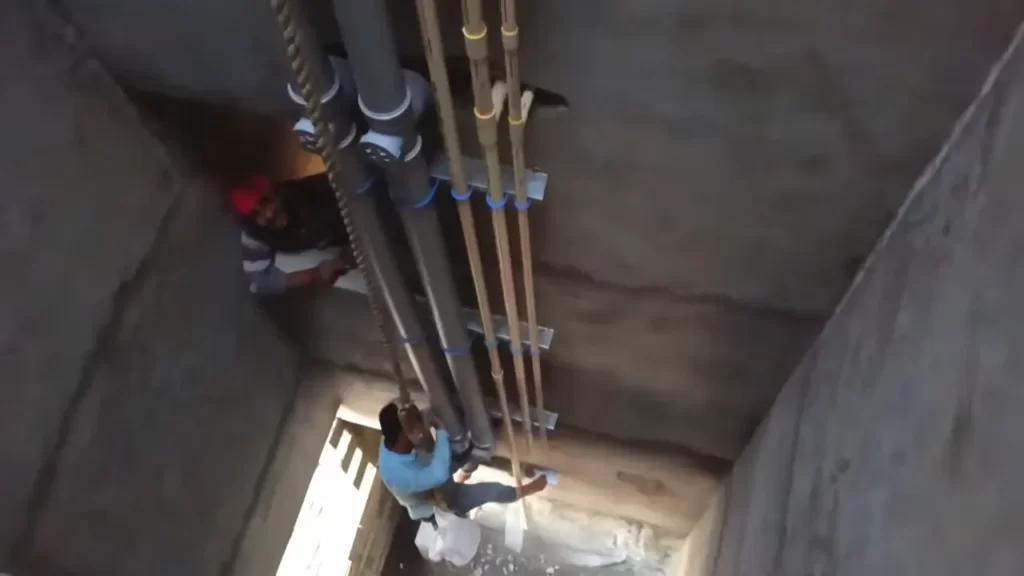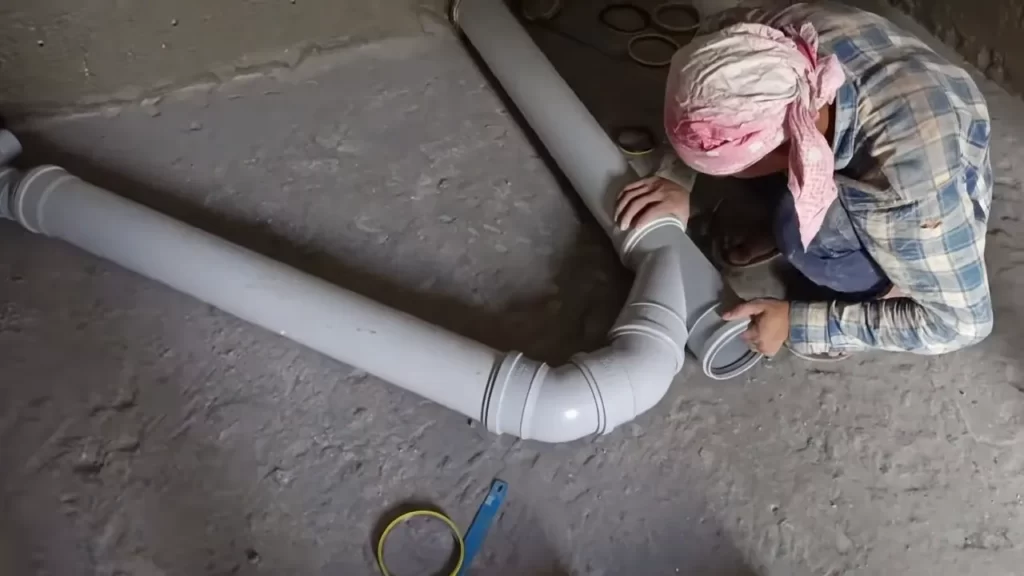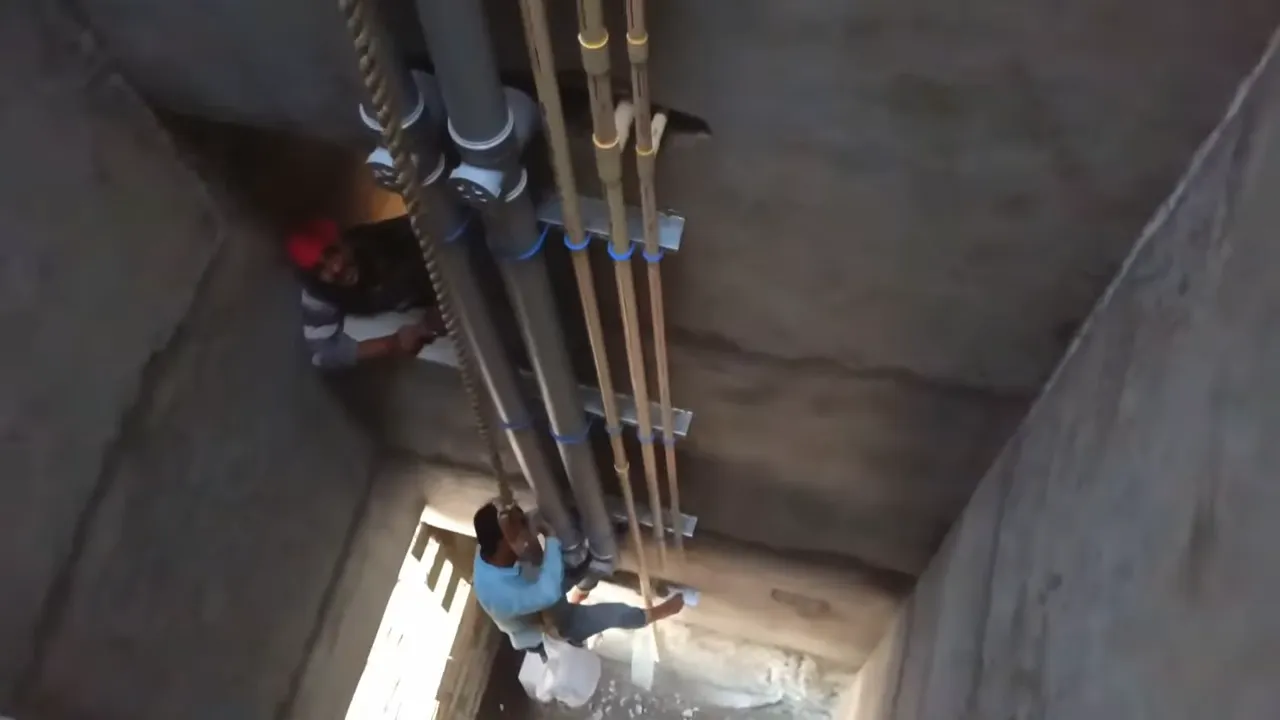To install a toilet drain pipe, start by measuring and marking the position for the drain pipe on the floor, then cut a hole in the subfloor for the drain pipe.
Understanding The Basics Of A Toilet Drain Pipe
Understanding the Basics of a Toilet Drain Pipe
When it comes to installing a toilet, one of the most crucial steps is installing the drain pipe correctly. The drain pipe is responsible for carrying waste from the toilet to the sewer or septic system, ensuring proper functionality of the toilet. In this section, we will delve into the components and anatomy of a toilet drain pipe, the importance of a properly installed drain pipe, as well as common issues and problems that can arise from improper installation.
Components and anatomy of a toilet drain pipe
To understand how a toilet drain pipe works, it’s essential to familiarize yourself with its components and anatomy. The drain pipe typically consists of several important elements:
| Component | Description |
|---|---|
| Flange | The flange is a circular fitting that connects the toilet bowl to the drain pipe. It provides a secure base for the toilet and creates a watertight seal. |
| Trap | The trap is a curved section of the drain pipe that holds water in order to prevent sewer gases from entering your home. It also helps to maintain proper drainage. |
| Vent Pipe | The vent pipe allows air to enter the drain system, preventing suction and ensuring efficient waste removal. It also helps to control odors. |
| Main Sewer Line | The main sewer line is the pipe that carries waste from the toilet drain pipe to the municipal sewer system or septic tank. |
Importance of a properly installed drain pipe for toilet functionality
A properly installed drain pipe is essential for the functionality of your toilet. Without it, waste cannot be efficiently and effectively removed, leading to potential blockages, leaks, and other serious issues. Here are a few reasons why a properly installed drain pipe is crucial:
- Proper drainage: A well-designed drain pipe ensures that waste flows smoothly from the toilet to the sewer or septic system, preventing clogs and backups.
- Odor control: The proper installation of a vent pipe allows sewer gases to escape, reducing unpleasant odors in your bathroom.
- Preventing water damage: A secure and watertight seal created by the flange prevents leaks, which can lead to water damage and costly repairs.
- Maintaining hygiene: A correctly installed drain pipe ensures that waste is disposed of safely and efficiently, promoting cleanliness and hygiene in your bathroom.
Common issues and problems with improper drain pipe installation
Improper installation of a toilet drain pipe can lead to various issues that can disrupt the functionality of your toilet and cause inconveniences in your home. Some common problems that can arise from improper drain pipe installation include:
- Clogs and backups: If the drain pipe is not properly aligned or has incorrect slope, it can result in frequent clogs and backups, making your toilet unusable.
- Leaks: Poor connections or a faulty flange seal can lead to leaks, causing water damage to your flooring and surrounding areas.
- Unpleasant odors: Without a vent pipe or with improper venting, sewer gases can build up in your bathroom, leading to foul smells.
- Overflowing toilets: Inadequate drainage due to incorrect pipe size or blockages can cause your toilet to overflow, creating a messy and unsanitary situation.
In conclusion, understanding the basics of a toilet drain pipe is essential for a successful installation. By knowing the components and anatomy of the drain pipe, the importance of proper installation, as well as the potential issues that can arise from improper installation, you can ensure a functional, efficient, and hygienic toilet in your home.

Preparing For The Installation Process
Preparing for the Installation Process
Before starting the installation process, it is essential to take certain safety precautions and gather the necessary equipment to ensure a smooth and successful toilet drain pipe installation. Additionally, assessing the existing plumbing system and determining the appropriate drain pipe size and material are vital steps that should not be overlooked.
Safety Precautions and Equipment Needed
When handling any plumbing project, safety should always be a top priority. Before beginning the toilet drain pipe installation, it is crucial to take the following precautions:
- Wear protective gloves to avoid contact with harmful chemicals or sharp objects.
- Use safety goggles to protect your eyes from potential debris or splashes.
- Ensure the working area is well-ventilated to avoid inhaling any fumes.
Having the right tools and equipment on hand will make the installation process significantly easier. Here are some essential items you may need:
- Adjustable wrench
- Hacksaw
- Teflon tape
- Plumber’s putty
- Measuring tape
- Pipe cutter
- Level
- Screwdriver
Assessing the Existing Plumbing System
Before installing a new toilet drain pipe, it is crucial to assess the existing plumbing system in your home. Take note of the following:
- Locate the main sewer line and determine its proximity to the bathroom where the new toilet will be installed.
- Check the condition of the existing drain pipe to ensure it is not damaged or obstructed.
- Assess the slope of the drain pipe to ensure proper wastewater flow.
- Note any existing vent pipes connected to the plumbing system, as they may need to be considered during the installation process.
Determining the Appropriate Drain Pipe Size and Material
Choosing the correct drain pipe size and material is paramount to the proper functioning of the toilet and the plumbing system as a whole. Here are some key factors to consider:
- Measure the diameter of the toilet’s waste outlet to determine the appropriate drain pipe size.
- Consider the local building codes and regulations that dictate the minimum size requirement for drain pipes.
- Select a drain pipe material that is durable, resistant to corrosion, and compatible with the existing plumbing system.
By carefully assessing the existing plumbing system and selecting the appropriate drain pipe size and material, you can ensure a seamless installation process and avoid potential issues in the future.

Step-By-Step Guide To Installing A Toilet Drain Pipe
Installing a toilet drain pipe may seem like a daunting task, but with the right tools and knowledge, it can be a relatively straightforward process. Whether you’re remodeling your bathroom or simply replacing an old toilet, this step-by-step guide will walk you through the process, ensuring a successful installation.
Shutting off the water supply and removing the old toilet
The first step in installing a toilet drain pipe is to shut off the water supply and remove the old toilet. This will require turning off the water valve located near the toilet’s base and flushing the toilet to drain any remaining water in the tank and bowl.
Once the water supply has been shut off, you can proceed to remove the old toilet. Start by disconnecting the water supply line from the bottom of the toilet tank using an adjustable wrench. Next, remove the nuts securing the toilet to the floor using a wrench or pliers. Carefully lift the toilet off the drain flange and set it aside in a safe location.
Clearing the area and measuring for the new drain pipe
With the old toilet removed, it’s important to clear the area and prepare it for the installation of the new drain pipe. Clean up any debris and inspect the flange for any damage or signs of wear. If necessary, replace the flange to ensure a proper seal.
Before cutting and fitting the new drain pipe, it’s essential to measure the distance between the toilet flange and the plumbing system. This will determine the length of the new drain pipe needed for the installation.
Cutting and fitting the new drain pipe
Once you have the measurements, it’s time to cut and fit the new drain pipe. Using a hacksaw or reciprocating saw, carefully cut the pipe to the appropriate length. Smooth out any rough edges with sandpaper or a file to ensure a proper fit.
After cutting the pipe, dry fit it into place, ensuring it aligns correctly with the toilet flange and plumbing system. Make any necessary adjustments and ensure there is a proper slope for efficient drainage.
Securing the drain pipe to the floor and connecting to the plumbing system
Once the new drain pipe is properly fitted, it’s time to secure it to the floor and connect it to the plumbing system. Use a drill and screws to firmly attach the flange to the floor, ensuring a tight seal. Apply plumber’s putty or silicone caulk around the base of the flange for added stability and to prevent leaks.
Next, connect the new drain pipe to the plumbing system. If using PVC pipes, apply PVC primer and adhesive to the pipe ends and fittings, then firmly push them together. For metal pipes, use appropriate fittings and connectors to ensure a secure connection.
Testing for leaks and ensuring proper functionality
With the new toilet drain pipe in place, it’s crucial to test for leaks and ensure proper functionality. Turn the water supply back on and allow the toilet tank to fill. Check for any signs of leakage around the flange, pipe joints, and fittings.
Once you’ve confirmed there are no leaks, flush the toilet several times to ensure proper drainage and functionality. Listen for any unusual sounds or clogs, and adjust as necessary.
By following this step-by-step guide, you can successfully install a toilet drain pipe, saving both time and money. Remember to take proper measurements, secure the pipe to the floor and plumbing system, and thoroughly test for leaks and functionality. With a little patience and attention to detail, you’ll have a fully functional toilet in no time. Happy installing!

Troubleshooting Common Installation Challenges
Troubleshooting Common Installation Challenges
Installing a toilet drain pipe can sometimes present certain challenges that require troubleshooting. In this section, we will discuss some common issues that may arise during the installation process and provide solutions to help you overcome them.
Dealing with Misaligned or Incompatible Pipes
A common challenge during toilet drain pipe installation is dealing with misaligned or incompatible pipes. This can happen due to variations in pipe sizes or obstructions in the path of the pipe. Here are some steps to help you address this issue:
- Measure and compare the sizes of the existing pipes and the new toilet drain pipe to ensure compatibility.
- If the pipes are misaligned, you may need to use a coupling or a flexible connector to bridge the gap between them.
- In some cases, you may also need to trim or adjust the pipes to align them properly.
Fixing Leaks and Ensuring a Watertight Seal
Another common challenge is leaks occurring in the toilet drain pipe system. To fix leaks and ensure a watertight seal, follow these steps:
- Inspect all connections between the pipes for any signs of leakage.
- Tighten any loose fittings with a wrench or pliers to ensure a secure connection.
- If you notice any cracks or damage to the pipes or fittings, replace them immediately.
- Apply plumber’s tape or pipe thread sealant to the threaded connections to create a watertight seal.
- Perform a water test by flushing the toilet multiple times and checking for any leaks. If you detect a leak, repeat the previous steps and make sure all connections are properly sealed.
Resolving Issues with the Toilet Not Flushing Properly after Installation
If you encounter the issue of the toilet not flushing properly after installation, follow these steps to identify and resolve the problem:
- Check if the toilet tank is properly filled with water. Adjust the water level if necessary.
- Ensure that the flapper valve or flush valve is functioning correctly. If it’s damaged or worn out, replace it with a new one.
- Inspect the water supply line for any obstructions or kinks that may restrict water flow. Straighten or replace the line if needed.
- Verify that the toilet’s trap and drain line are clear of any clogs. Use a plunger or a plumbing snake to remove any blockages.
- If the issue persists, you may need to consult a professional plumber to further diagnose and resolve the problem.
By following these troubleshooting steps, you can overcome common challenges that may arise during the installation of a toilet drain pipe. These solutions will help you achieve a successful and problem-free installation. Remember to take the necessary precautions and always seek professional help if needed.

Maintenance Tips For A Reliable Toilet Drain Pipe
Regular inspections and cleaning procedures
Maintaining a reliable toilet drain pipe is essential to ensure the smooth functioning of your plumbing system. Regular inspections and cleaning procedures play a vital role in preventing potential issues and keeping your toilet drain pipe in optimal condition.
To start, make it a habit to inspect your toilet drain pipe at regular intervals. This is an excellent preventive measure that allows you to identify any signs of wear and tear, leaks, or blockages before they escalate into significant problems. Keep an eye out for cracks, corrosion, or loose connections, as these may indicate potential issues that require immediate attention.
In addition to inspections, regular cleaning of your toilet drain pipe is crucial in maintaining an efficient and reliable system. Over time, mineral deposits, debris, and grease can accumulate in the drain pipe, leading to clogs and reduced water flow. To prevent this, it is recommended to flush your toilet with hot water and a mixture of baking soda and vinegar once a month. This natural solution helps break down any buildup and keeps your drain pipe clear.
Addressing minor clogs and blockages
Occasionally, you may encounter minor clogs or blockages in your toilet drain pipe. These can typically be resolved with simple maintenance procedures.
If you notice slow draining or water backup in your toilet, try using a plunger to dislodge the clog. Position the plunger over the drain and create a tight seal. Then, push and pull in a steady motion to create pressure and dislodge the obstruction. Repeat this process a few times if necessary.
If plunging does not resolve the issue, you can try using a plumber’s snake or auger. Insert the snake into the drain pipe and rotate it to break up any stubborn clogs. Carefully pull it out, taking care not to damage the pipe or push the obstruction further into the system.
Signs of potential drain pipe problems and when to seek professional help
While regular maintenance and addressing minor clogs can prevent many issues with your toilet drain pipe, there are certain signs that may indicate more significant problems. It is essential to be aware of these signs and seek professional help when necessary.
If you notice recurring clogs, unpleasant odors, gurgling sounds, or water leaks around the toilet base, these could be indications of a more serious drain pipe problem. These issues may require professional inspection and repair to prevent further damage to your plumbing system.
Additionally, if you have attempted basic maintenance procedures without success or if you are unsure about the severity of the problem, it is always best to contact a qualified plumber. They have the expertise and tools to diagnose and address any drain pipe issues effectively.
Maintaining a reliable toilet drain pipe through regular inspections, cleaning procedures, and addressing minor clogs can help prevent potential plumbing emergencies. However, it is crucial to be aware of signs of potential problems and seek professional assistance when needed. By taking these maintenance tips on board, you can ensure the longevity and optimal performance of your toilet drain pipe.
Frequently Asked Questions
How Do You Connect A Toilet Waste Pipe?
To connect a toilet waste pipe: 1. Position the toilet in the desired location. 2. Attach the wax ring to the bottom of the toilet. 3. Carefully lower the toilet onto the flange, making sure it aligns with the waste pipe.
4. Secure the toilet to the floor with bolts. 5. Lastly, connect the waste pipe to the toilet using a flange and tighten it securely.
How Much Does It Cost To Install A Toilet Drain Pipe?
Installing a toilet drain pipe can cost around $200-$800, depending on factors like the difficulty of the installation, location, and additional expenses for materials. It’s best to consult with a professional plumber for an accurate estimate.
What Kind Of Pipe Is Used For Toilet Drain?
Toilet drains typically use PVC pipes, which are durable and resistant to corrosion. PVC pipes are commonly used due to their affordability and ease of installation. They provide a smooth flow of waste and are designed to handle the constant use and pressure associated with toilet drainage.
How Deep Is A Toilet Drain Pipe?
A toilet drain pipe is typically about 3 to 4 inches in diameter. It runs vertically from the toilet bowl to the sewer or septic tank underground. The depth of the pipe depends on the local building codes and the plumbing layout of the property.
Conclusion
To sum up, installing a toilet drain pipe may seem like a daunting task, but with the right guidance, it can be accomplished smoothly. By following the steps mentioned in this blog post, you’ll be able to successfully complete the installation process.
Remember to ensure a secure and leak-free connection, and always prioritize safety. Happy DIY plumbing!
